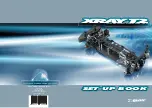
46
Assembly instructions, figure 7 (B-3):
Figure 7 shows the components of the pre-assembled differential. The differential is already pre-greased. When dis-
mantling the differential for maintenance purposes, clean it and add fresh grease (add just sufficient amount of grease,
do not fill the differential with grease to the brim!).
Assembly instructions, figure 8 (B-4):
First put one of the two thin metal rings on each of the differential attachments followed by the two ball bearings. Then
insert it into the differential housing as well as the pre-assembled friction clutch. Pay attention to the position of the
two ball bearings on the friction clutch axle in the differential housing.
Use the metal rings to adjust the play between the two gears. The gears should not turn too tight, but there
should not be too much play either. The position of the differential can be adjusted with the metal rings,
which must be placed between the differential and the ball bearing.
A somewhat thicker metal ring is typically not required. However, in order to achieve an optimal position of
the gears, it may be necessary to use several metal rings combined with one another in different ways due
to the production tolerances of plastic parts.
Apply a suitable gear grease to the gears (apply just sufficient amount of grease, but do not fill the gear housing to
the brim!).
Finally, place the plastic part pre-assembled in figure 5 on the differential housing and secure it with four M3 x 18
screws.
Assembly instructions, figure 9 (C-1):
Insert the motor support plate with the rear axle differential mounted on it into the chassis pan.
Our tip:
You may have to loosen the M4 x 4 set screw (see figure 6) that secures the cardan shaft attachment once
again so that the differential housing can be correctly inserted into the opening in the chassis pan. Secure
the cardan shaft attachment again with the set screw after the motor support plate and differential housing
have been screwed tight in the chassis pan.
First secure the differential housing with two M3 x 15 screws in the chassis pan and then the motor support plate with
two M3 x 10 screws.
Finally, screw the motor support plate tight to the chassis pan using two M3 x 10 countersunk screws and two M3
locking nuts (a detailed illustration of the underside of the chassis pan and the position of the two countersunk screws
can be found in the bottom left of figure 9).
The locking nuts can be easily inserted at the desired location with needle-nose pliers.
Now check whether the main gear (and the associated rear axle differential) can be turned easily. It must not turn tight!
Summary of Contents for 2347928
Page 138: ...138 ...
Page 139: ...139 ...
















































